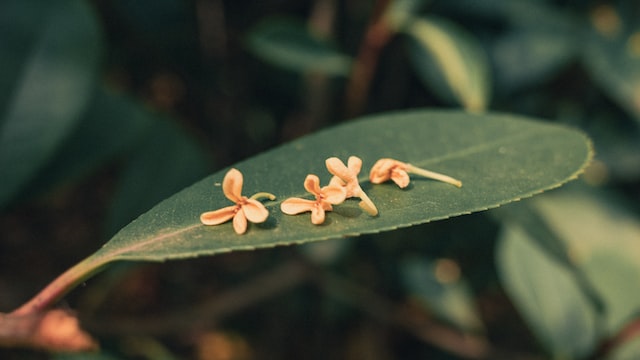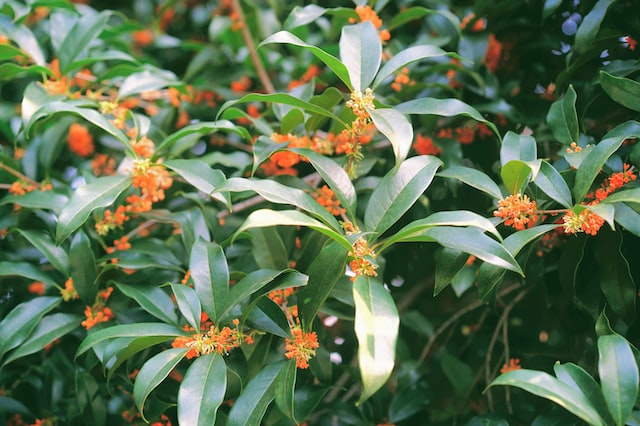Unveil the Allure of Osmanthus Fragrance
Osmanthus: The Fragrant Blossom of Elegance and Serenity
Introduction: Osmanthus, with its delicate and enchanting fragrance, is a treasured flower that has been admired for centuries. Native to Asia, this exquisite blossom belongs to the genus Osmanthus and is known for its unique aroma, reminiscent of apricots, peaches, and orange blossoms. Osmanthus has found its way into various aspects of human life, from perfumery and therapeutic oils to culinary delights and traditional medicine. This essay explores the captivating world of osmanthus, encompassing its presence in perfumes, therapeutic oils, food, medicinal systems, historical significance, and intriguing fun facts about this delightful and alluring flower.
The Enchantment of Osmanthus: Osmanthus flowers are small and unassuming, but they carry a powerful and captivating fragrance. The blossoms bloom in clusters, emanating a sweet and fruity scent that is both floral and fruity. There are several species of osmanthus, with Osmanthus fragrans being the most well-known for its aromatic properties.
Perfumes and Fragrance: Osmanthus absolute is a prized ingredient in perfumery. The delicate and intoxicating aroma of osmanthus adds a touch of elegance and serenity to fragrance compositions. It is often used as a middle note in perfumes, harmoniously blending with other floral and fruity scents. Osmanthus' unique fragrance makes it a popular choice in high-end and niche perfumes, where it imparts a sense of luxury and sophistication.
Therapeutic Oils and Aromatherapy: Osmanthus essential oil is not as widely available as some other essential oils, and it is not commonly used in mainstream aromatherapy. However, some practitioners and aromatherapy enthusiasts may use osmanthus oil for its potential calming and mood-uplifting properties. The aroma of osmanthus is believed to soothe the mind and promote relaxation.
Culinary Delights: Osmanthus flowers are used in culinary creations, particularly in East Asian cuisine. The flowers are infused in teas, sweets, and desserts, adding their delightful fragrance and a touch of sweetness to the dishes. Osmanthus-infused tea is especially popular during festivals and special occasions in certain Asian cultures.
Medicinal and Traditional Uses: Osmanthus has a long history of medicinal use in traditional Chinese medicine. In Chinese herbalism, osmanthus flowers are believed to have potential health benefits, such as promoting digestive health and relieving respiratory issues. The flowers are also believed to have cooling properties, making them valuable in herbal remedies for reducing internal heat and inflammation.
Historical Significance: Osmanthus holds cultural significance in various Asian countries, where it is associated with beauty, elegance, and purity. In China, osmanthus is one of the "Four Gentlemen" of flowers, representing the four seasons. It is also a symbol of love and romance in Chinese folklore. Osmanthus has been cherished for centuries in East Asia, and its essence has found its way into various aspects of the region's culture and traditions.
Fun and Crazy Facts:
Osmanthus, with its enchanting and captivating fragrance, is a treasured flower that has charmed and inspired cultures for centuries. From its presence in perfumes and culinary delights to its potential therapeutic properties in traditional medicine, osmanthus continues to be a symbol of elegance, serenity, and beauty. As we immerse ourselves in the alluring aroma of osmanthus, we are reminded of the deep connection between flowers and human emotions, and the timeless allure of nature's botanical treasures.
Introduction: Osmanthus, with its delicate and enchanting fragrance, is a treasured flower that has been admired for centuries. Native to Asia, this exquisite blossom belongs to the genus Osmanthus and is known for its unique aroma, reminiscent of apricots, peaches, and orange blossoms. Osmanthus has found its way into various aspects of human life, from perfumery and therapeutic oils to culinary delights and traditional medicine. This essay explores the captivating world of osmanthus, encompassing its presence in perfumes, therapeutic oils, food, medicinal systems, historical significance, and intriguing fun facts about this delightful and alluring flower.
The Enchantment of Osmanthus: Osmanthus flowers are small and unassuming, but they carry a powerful and captivating fragrance. The blossoms bloom in clusters, emanating a sweet and fruity scent that is both floral and fruity. There are several species of osmanthus, with Osmanthus fragrans being the most well-known for its aromatic properties.
Perfumes and Fragrance: Osmanthus absolute is a prized ingredient in perfumery. The delicate and intoxicating aroma of osmanthus adds a touch of elegance and serenity to fragrance compositions. It is often used as a middle note in perfumes, harmoniously blending with other floral and fruity scents. Osmanthus' unique fragrance makes it a popular choice in high-end and niche perfumes, where it imparts a sense of luxury and sophistication.
Therapeutic Oils and Aromatherapy: Osmanthus essential oil is not as widely available as some other essential oils, and it is not commonly used in mainstream aromatherapy. However, some practitioners and aromatherapy enthusiasts may use osmanthus oil for its potential calming and mood-uplifting properties. The aroma of osmanthus is believed to soothe the mind and promote relaxation.
Culinary Delights: Osmanthus flowers are used in culinary creations, particularly in East Asian cuisine. The flowers are infused in teas, sweets, and desserts, adding their delightful fragrance and a touch of sweetness to the dishes. Osmanthus-infused tea is especially popular during festivals and special occasions in certain Asian cultures.
Medicinal and Traditional Uses: Osmanthus has a long history of medicinal use in traditional Chinese medicine. In Chinese herbalism, osmanthus flowers are believed to have potential health benefits, such as promoting digestive health and relieving respiratory issues. The flowers are also believed to have cooling properties, making them valuable in herbal remedies for reducing internal heat and inflammation.
Historical Significance: Osmanthus holds cultural significance in various Asian countries, where it is associated with beauty, elegance, and purity. In China, osmanthus is one of the "Four Gentlemen" of flowers, representing the four seasons. It is also a symbol of love and romance in Chinese folklore. Osmanthus has been cherished for centuries in East Asia, and its essence has found its way into various aspects of the region's culture and traditions.
Fun and Crazy Facts:
- Osmanthus Festivals: Some regions in China celebrate osmanthus festivals, where people gather to admire the blossoms, enjoy osmanthus-infused foods, and participate in cultural events.
- Osmanthus in Art and Literature: Osmanthus has been a popular theme in traditional Chinese art and poetry, symbolizing beauty, elegance, and the changing seasons.
- Osmanthus Fragrance in Tea: When brewing osmanthus-infused tea, the fragrance of the flowers is released, creating a delightful sensory experience during tea preparation and consumption.
- Osmanthus Mythology: In Chinese mythology, the moon rabbit is said to reside in the osmanthus tree on the moon, creating a connection between the flower and lunar imagery.
- Osmanthus and Cosmetics: The fragrance of osmanthus is sometimes used in cosmetics, perfumed lotions, and beauty products.
Osmanthus, with its enchanting and captivating fragrance, is a treasured flower that has charmed and inspired cultures for centuries. From its presence in perfumes and culinary delights to its potential therapeutic properties in traditional medicine, osmanthus continues to be a symbol of elegance, serenity, and beauty. As we immerse ourselves in the alluring aroma of osmanthus, we are reminded of the deep connection between flowers and human emotions, and the timeless allure of nature's botanical treasures.
To experience augmented reality, please open the Facebook-app using QR code and point to the image below
Captivating Floral Sweetness
Osmanthus (Osmanthus fragrans) is a species of olive tree that is native to China and parts of Asia. It is known for its small, white, pink, or orange flowers which have a strong, sweet, and fruity fragrance. The fragrance is often described as apricot-like, and it is highly prized in perfumery and aromatherapy.
The tree itself is an evergreen, and can grow up to 30 feet tall. The leaves are dark green and glossy, and the small flowers are borne in clusters. Osmanthus is often used as a hedge or ornamental tree in landscaping.
The flowers are also used to make tea, which is said to have a number of health benefits, including reducing stress, improving digestion and fighting colds and the flu.
In perfumery and aromatherapy, Osmanthus essential oil is used to create a sweet, floral, and fruity scent. It is often used as a middle or base note in perfumes and as a blending oil in aromatherapy. It's used to create perfumes with a floral-fruity scent, also it's used to create perfumes with a fresh and delicate aroma.
It's used in perfumes from various famous perfume brands such as "Osmanthus" by Jo Malone, "Osmanthus" by Tom Ford, "Osmanthus" by L'Artisan Parfumeur, and more.
The tree itself is an evergreen, and can grow up to 30 feet tall. The leaves are dark green and glossy, and the small flowers are borne in clusters. Osmanthus is often used as a hedge or ornamental tree in landscaping.
The flowers are also used to make tea, which is said to have a number of health benefits, including reducing stress, improving digestion and fighting colds and the flu.
In perfumery and aromatherapy, Osmanthus essential oil is used to create a sweet, floral, and fruity scent. It is often used as a middle or base note in perfumes and as a blending oil in aromatherapy. It's used to create perfumes with a floral-fruity scent, also it's used to create perfumes with a fresh and delicate aroma.
It's used in perfumes from various famous perfume brands such as "Osmanthus" by Jo Malone, "Osmanthus" by Tom Ford, "Osmanthus" by L'Artisan Parfumeur, and more.
Experience Elegance and Long-lasting Charm
Osmanthus (Osmanthus fragrans) has a long history of cultivation and use in China and other parts of Asia. The plant is native to China, and it is believed to have been cultivated there for thousands of years. It was traditionally used in Chinese medicine to treat a variety of ailments, including diarrhea, constipation, and dysentery.
The sweet-smelling flowers of Osmanthus were also highly valued for their fragrance, and were used in perfumes and incense. The Chinese have been known to use Osmanthus flowers in perfumes, teas, and as a flavoring in traditional foods.
Osmanthus was also used in traditional Chinese gardening, and it was often planted in imperial gardens, as well as in private gardens of the wealthy. The trees were also planted along roads and in public spaces to provide a pleasant fragrance.
Osmanthus was introduced to Japan in the Heian period (794-1185) and it quickly became a beloved flower. It was used as a symbol of autumn and it was enjoyed as a tea and in perfumes.
In the West, Osmanthus was first introduced by the French missionary, Père Armand David, who brought back seeds and cuttings from China in the late 1800s. It has since become a popular ornamental plant in Europe and North America, prized for its fragrant flowers and its ability to thrive in a wide range of climates.
Today, Osmanthus is widely cultivated in many parts of the world, and it is used in perfumery, aromatherapy, and traditional medicine, as well as in gardening and landscaping.
The sweet-smelling flowers of Osmanthus were also highly valued for their fragrance, and were used in perfumes and incense. The Chinese have been known to use Osmanthus flowers in perfumes, teas, and as a flavoring in traditional foods.
Osmanthus was also used in traditional Chinese gardening, and it was often planted in imperial gardens, as well as in private gardens of the wealthy. The trees were also planted along roads and in public spaces to provide a pleasant fragrance.
Osmanthus was introduced to Japan in the Heian period (794-1185) and it quickly became a beloved flower. It was used as a symbol of autumn and it was enjoyed as a tea and in perfumes.
In the West, Osmanthus was first introduced by the French missionary, Père Armand David, who brought back seeds and cuttings from China in the late 1800s. It has since become a popular ornamental plant in Europe and North America, prized for its fragrant flowers and its ability to thrive in a wide range of climates.
Today, Osmanthus is widely cultivated in many parts of the world, and it is used in perfumery, aromatherapy, and traditional medicine, as well as in gardening and landscaping.
The Elegance of Osmanthus Perfume
Osmanthus, also known as sweet osmanthus or sweet olive, is a plant that is commonly used in traditional Chinese medicine. The plant is believed to have various therapeutic properties, including anti-inflammatory, anti-tumor, and antioxidant effects. Osmanthus is also commonly used to help with respiratory issues, such as asthma and bronchitis, and to treat skin conditions, such as eczema and psoriasis. Additionally, osmanthus is believed to have stress-relieving and mood-boosting effects. However, more research is needed to confirm these effects and to determine the appropriate dosage and methods of use.
Crafting the Perfect Floral Sweet Blend
The scent of osmanthus is often described as sweet and floral, with hints of apricot or peach. The fragrance of osmanthus is said to be calming, soothing and uplifting, and is believed to help alleviate stress, anxiety and depression. In aromatherapy, osmanthus essential oil is used to promote a sense of well-being and to improve mood. The oil can be inhaled directly, added to a diffuser, or used in a massage blend. Osmanthus is also used in perfumery, as the flower's unique aroma is highly valued for its delicate and complex fragrance.
Additionally, Osmanthus is also used in traditional Chinese medicine, where it is believed to help improve circulation and to relieve pain. It is also said to have a warming effect on the body, making it particularly useful for people who feel cold all the time.
Please note that aromatherapy should not be used as a substitute for professional medical treatment, and that essential oils should be used with caution and under the guidance of a qualified practitioner.
Additionally, Osmanthus is also used in traditional Chinese medicine, where it is believed to help improve circulation and to relieve pain. It is also said to have a warming effect on the body, making it particularly useful for people who feel cold all the time.
Please note that aromatherapy should not be used as a substitute for professional medical treatment, and that essential oils should be used with caution and under the guidance of a qualified practitioner.
Discover Scentopia's Perfume Collection
Osmanthus is a popular ingredient used in perfumery. Many famous perfume brands have included osmanthus in their fragrances. Some examples include:
- Jo Malone Peony & Blush Suede: This fragrance features osmanthus alongside notes of peony and suede to create a floral and sensual scent.
- Tom Ford Private Blend Orchid Soleil: This perfume features osmanthus as a central note, complemented by orchid and other floral notes to create a sweet and exotic scent.
- Chanel No. 5: This iconic fragrance features osmanthus as one of its notes, adding to the floral and powdery scent of the perfume.
- Dior J'adore: Osmanthus is one of the notes of the iconic fragrance, adding a floral and fruity touch to the fragrance.
- Gucci Flora: Osmanthus is one of the notes of the floral fragrance, adding a sweet and fruity touch to the fragrance
Join Scentopia, Sentosa's latest tourist attraction wonderful orchid scent crafting, fragrance tour, bridal shower or corporate team building which includes perfume making onsite and offsite, beach activities and more. We also serve primary school learning journey, secondary students and pupil on industrial excursions. Know more about our orchids perfume bar or therapeutic orchid scents and other wellness aromas. Conatct Perfume workshop or book a scent crafting session here.






